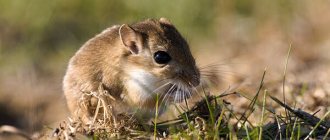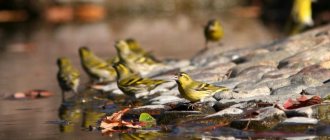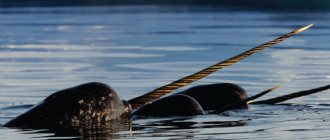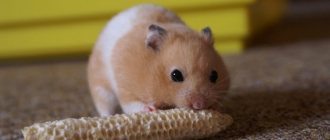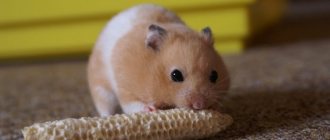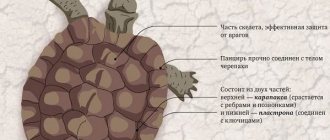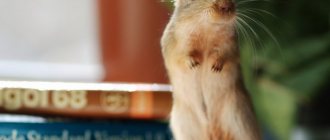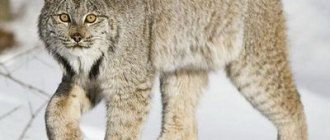Chinchillas are a genus of mammals from the chinchilla family. The chinchilla's range in the wild is limited to the highlands of South America. The valuable fur of the animals has become the reason for their intensive extermination since the appearance of European colonialists on the continent. All conservation measures taken have not helped stop the population decline. In 2008, chinchillas were classified as an “endangered species” in the International Red Book. Numerous attempts to introduce the genus in Mexico and some Asian countries, as well as to populate the natural habitat with animals bred in captivity, have not yielded positive results.
At the beginning of the last century, the first attempt was made to adapt a rodent to life in captivity. Today, chinchilla farms can be found all over the world, and some of them are engaged not only in breeding, but also in breeding work. Animals are also very popular as pets.
From whom did they come?
The prehistoric ancestors of chinchillas are considered to be animals called Meegamys by scientists. Their fossilized remains were found during excavations in the habitats of modern rodents. The age of the finds is about 40 thousand years. The biological structure of Meegamys is similar to chinchillas, but their size is much larger.
Based on the results of the excavations, a hypothesis was built that explains not only the origin of chinchillas, but also the unique properties of the animal’s fur. According to the researchers, during the process of evolution there was a gradual decrease in the size of individuals, but the number of hair follicles remained the same. As a result of these changes, the hair follicles on the skin of chinchillas are much denser than in other animals.
The closest relatives of chinchillas are porcupines, and the closest relatives in biological structure are considered to be viscacha, a genus from the chinchilla family.
History of domestication
Under conditions of artificial breeding, chinchillas fare much better. Its cute appearance, unpretentiousness, good health and good-natured disposition have made this rodent very popular for home breeding and keeping. The first animals were domesticated at the beginning of the last century. American Mathias Chapman brought eleven individuals from Chile. All modern breeds and color morphs originate from them. Initially, chinchillas were bred only to obtain valuable fur.
By the middle of the last century, chinchilla farms appeared on all continents.
Breeders began to develop new color morphs - the genetics of the animals make it possible to obtain rodents with colors ranging from silver-white to jet-black. And already from the mid-80s of the last century, chinchillas began to gain popularity as pets.
Description of the animal
Chinchillas are school animals. They form groups, the number of which can reach several dozen individuals. Each colony has an individual, usually a female, who monitors the habitat of the flock and gives a signal in case of danger.
Rodents are nocturnal. They have well-developed hearing and vision; orientation in the dark is also provided by vibrissae; their length can reach 10 cm.
The sounds that chinchillas make depend on the condition of the animal:
- to communicate with other individuals or attract attention, animals make sounds reminiscent of cooing or grumbling;
- short and smooth sounds are a call for mating;
- if a rodent gets angry or shows dissatisfaction, it grinds its teeth;
- a sharp and short squeak is a sign of fear or approaching danger.
Due to the small number of chinchillas in nature and their nocturnal lifestyle, most information about the rodent was obtained based on observations of individuals kept in captivity.
What sounds does a chinchilla make?
What does it look like
The appearance of a chinchilla has the following features:
- the body and head are rounded and slightly elongated, the neck is short;
- the ears are round, there are membranes inside the auricles that cover the hearing aid while taking sand baths;
- the front legs have four grasping fingers, the hind legs are longer, thanks to which the animal is able to jump far and develop high speed;
- There are 20 teeth in the oral cavity, 4 of which are incisors; they grow throughout life and need constant grinding.
The average size of an adult chinchilla is in the range of 22-30 cm, and its weight is 700-800 g. Tail length is from 70 to 17 cm. The largest chinchilla can reach sizes of 35-38 cm and weight up to 1 kg.
How to distinguish a female from a male
Sexual dimorphism in chinchillas is practically not expressed in appearance: individuals of both sexes have the same size and color and differ slightly in size (females are larger). The only difference that makes it possible to accurately determine gender is the structure of the genital organs.
To determine the sex of the animal, you need to pick it up, lift its tail and estimate the distance between the anus and the protruding tip. In the female they are located nearby, and in the male they are located at a short distance.
Chinchilla fur
The special properties of the rodent's coat are provided by the unusual structure of the hair follicles, each of which contains from 60 to 80 villi, while the guard hairs found in other animals are completely absent.
Thanks to such dense fur, chinchillas are able to live in cold mountain climates, where temperatures drop to -30 degrees. Due to the high density of villi, they do not have ectoparasites.
Since this type of rodent lacks sebaceous and sweat glands, their fur is not protected from moisture. To dry the coat and remove dead hairs and dirt, the chinchilla bathes in fine dust or sand.
In terms of softness and density of fur, the chinchilla surpasses all wild mammals. Animal skins were used to make clothing items by the ancient Indians. At the same time, chinchilla fur was considered a luxury, available only to leaders and other titled members of the tribes, and the capture of animals was limited.
With the advent of Spanish settlers in South America, mass trapping of rodents began in order to obtain skins for export to Europe. Commercial hunting has become so widespread that a new profession has emerged in Chile: “chinchillero” (chinchilla hunter).
It is impossible to establish exactly how many animals were exterminated before the complete ban on hunting in 1929. According to surviving data on legal exports, more than 7 million chinchilla skins were exported to Europe from 1840 to 1916 alone.
Among the most expensive furs in the world, chinchilla ranks fourth.
COMMON BEAVER
Population and species status
Today we can safely say that these animals are facing complete extinction. This mainly concerns chinchilla populations in the wild. According to experts, over the past 15 years the total number of these animals has decreased by almost 90 percent. In 2021, scientists knew of only 42 colonies of animals living within the South American continent. Scientists also believe that there are so few animals left that there is no need to talk about an increase in the population.
Interesting moment! A chinchilla fur coat is valued at $20,000, so it’s not surprising that these animals are so mercilessly destroyed. To sew one fur coat, you will have to destroy at least a hundred adult individuals.
They began sewing such fur coats in Europe in the 19th century. From 1828 to 1916, about 7 million skins were exported from Chile, and in total up to 21 million animals were destroyed and exported. The figure is such that the hair on the head rises spontaneously. Only in 1898 were laws passed prohibiting hunting and export. Unfortunately, it was very late and such bans are no longer able to influence the decrease in the total number.
Types of chinchillas
The genus is represented by only two species.
Long-tailed
The full name of the species is the small long-tailed coastal chinchilla. Individuals have a long tail, and their ears are also slightly longer than those of short-tailed chinchillas.
It was this species that was domesticated and is used for breeding to this day. After rodent hunting was banned, long-tailed chinchillas were captured for some time to improve the genetic diversity of captive rodents.
Short-tailed
The species is also known as the royal chinchilla. A distinctive feature of individuals is a shorter tail and a large body. Representatives of the species have a hump on their nose, which allows them to breathe cold mountain air and settle at an altitude of up to 3 thousand meters above sea level.
The fur of short-tailed chinchillas is thicker and is more valuable. Until 1960, the species was considered extinct, but after that several scattered small colonies were identified, and the species was classified as endangered.
How chinchillas were domesticated
When the demand for the luxurious fur of these animals throughout the feast reached unprecedented proportions, many people began to think about raising chinchillas in captivity. But all attempts to domesticate furry creatures failed, because no one knew what conditions they needed for reproduction, or even how to properly maintain them. And only the American Matthias Chapman managed to successfully breed these animals and establish the first chinchilla farm.
Breeding chinchillas on a farm
It is noteworthy that initially Mr. Chapman did not have such a goal. He had never worked with animals, since he was a mining engineer, not a breeder, and did not even know about the existence of chinchillas. Matias was working in a mine in Chile, and one day a local Indian approached him with a strange animal in his arms. The interested engineer began asking the visitor about his pet, and he offered to buy the rodent. The American didn’t even hesitate, he really liked the fluffy animal, and without hesitation paid the Indian the required amount.
Where do they live?
The historical homeland of the chinchilla is South America. Colonies of animals lived almost along the entire western coast. During the period of active trapping of fur-bearing animals, hunters burned vegetation to get to their burrows and shelters. A significant decrease in the number of animals, as well as the destruction of some plant species, reduced the habitat of the genus.
Currently, chinchillas are found only in central Chile, where the Chinchilla National Reserve was created in 1983 to preserve them.
Where do chinchillas live?
The usual habitat is mountainous terrain with little vegetation. Animals make shelters for themselves between stones, in crevices, caves; if necessary, they can dig a hole or make a home in the abandoned holes of other animals.
Plain viscacha (viscacha)
This small animal lives in South America, almost throughout its entire territory. Plain viscacha prefers flat terrain, hence the name. The habitat also includes the inaccessible humid lowlands of South America.
Plain viscacha
Plain viscachas are colonial animals. These animals have a pronounced difference between the sexes. Males are much larger than females, and their faces have a peculiar coloring. Males are also distinguished by a larger head. At home or on a farm, lowland viscachas live up to ten years. It is noteworthy that these viscachas have a very interesting habit of placing various so-called “works of art” at the entrance to their home - in the form of shiny stones, dry stems or bird feathers. Whizcachas can use whatever they like, even candy wrappers and cans. If a local resident loses an object near the viscachas, in the morning he often finds the item at the entrance to the hole, which the viscachas have already placed in their so-called “museum.”
Conclusion
As it turned out, the history of the chinchilla family is very interesting and fascinating, and dates back to prehistoric times. Although not everything has been studied regarding chinchillas, perhaps soon we will be able to find the key to unraveling the mysteries of the amazing life of these beautiful animals.
Reproduction
Chinchillas reach sexual maturity at the age of 6-9 months, with females maturing earlier than males. Despite the fact that rodents live in colonies, mating occurs with one permanent partner.
The first rut begins in the spring. The gestation period lasts a little more than 3 months. During this time, the female noticeably gains weight, and just before giving birth, she practically stops moving. 2-3 cubs are born in one litter. The animals are born sighted, they have teeth and are covered with fur. The female feeds the babies with milk for up to two months, but already on the 2-3rd day they begin to try plant foods.
Females give birth 2-3 times a year. Re-coating by the male occurs almost immediately after birth. Despite the ability of chinchillas to produce offspring several times per season, reproduction of the species does not occur as intensively as in other rodents due to the small number of litters.
Animals reproduce well in captivity. Thanks to many years of breeding work, it was possible to obtain many varieties with different fur colors. Today on chinchilla farms you can find individuals with a standard gray color, as well as beige, silver, white, black, brown, and purple. The rarer and more difficult the color mutation to obtain, the higher the price of the chinchilla.
Care and maintenance of chinchillas at home
Keeping a chinchilla at home is no less popular than keeping a guinea pig. First of all, to keep a chinchilla you will need a spacious cage. It is better if the cage is of a tower type. The optimal solution in this case would be a display case for a chinchilla, which will be an excellent home for the animal and will fit well into the home interior. A display case for a chinchilla will satisfy all the needs of a rodent; it has a house, stairs, floors, balconies, a running wheel and other toys. In addition, cleaning in such a display case is even easier than in a cage.
Keeping a chinchilla requires maintaining a certain temperature. The chinchilla animal does not tolerate heat well, so the cage should be placed in a cool place, without direct sunlight and drafts. The optimal temperature for keeping a chinchilla will be +20-22 °C. At temperatures of +25 °C and above, the rodent will overheat. Never place the cage near batteries.
The bottom of the cage must be lined with sawdust or special filler. The animal goes to the toilet anywhere and it is very difficult to train a chinchilla to do it in one place. The litter will have to be changed at least once a week. It is better to hang the feeder and water bowl, otherwise the chinchilla may turn them into a toilet.
Caring for a chinchilla at home includes taking care of the rodent's coat. Chinchilla fur gets dirty very quickly, so the animal needs frequent hygiene procedures. But the chinchilla bathes not in water, but in special sand. Chinchillas take sand baths with diligence and sand will fly in all directions. Therefore, it is advisable to carry out this procedure outside the cage, so as not to collect sand later. The best option in this case would be a round aquarium or any other deep, stable, round-shaped container. Place it on the floor, lay newspaper under it, pour a 5-6 cm layer of sand on the bottom and put the animal there for 20-30 minutes.
Caring for a chinchilla at home includes bathing at least 2 times a week. If your home has high humidity and temperatures close to +25 °C, bathing should be done 3 times a week. Bathing is a must for an animal if you want your chinchilla to have beautiful fur. Do not forget that swimming in water is harmful to a chinchilla and will cause health problems.
Also remember that ordinary sand (sea, river) is not suitable for swimming. After all, in the wild, the chinchilla animal bathes in volcanic dust, and not in sand. Therefore, at home it is permissible to use only special sand. In addition, in ordinary sand, an animal can become infected with fungus, parasites or skin diseases. To prevent skin diseases, antifungal drugs can be added to special sand.
In general, caring for and maintaining a chinchilla at home does not require much effort. The main condition is to protect the animal from overheating and maintain the correct diet. Try not to leave the animal unattended outside the cage. Remember that rodents love to taste everything and you will be guaranteed damaged furniture. The main danger lies in electrical wires. Also, do not forget that any hard-to-reach space in the apartment will be immediately explored by a curious animal.
The chinchilla, the maintenance and care of which is quite simple, has a number of advantages and one disadvantage. The advantages include the small cost of the animal, beautiful appearance, lack of odor and shedding, and peaceful character. But the disadvantage is the nocturnal lifestyle. If you decide to get such an animal, you will have to get used to rustling, squeaking and fussing at night.
Natural enemies
In their natural habitat, rodents become food for foxes, snakes, and large birds of prey. Protection from enemies is the camouflage coloring of the fur, good reaction and coordination, and speed of movement. Hiding from persecution, chinchillas hide in crevices and voids. The structural features of the skeleton enable the animal to penetrate narrow openings and crevices. Another unique feature of the chinchilla is that it can literally shoot out tufts of fur, discarding it in the place where the predator has grabbed hold.
A LION
Chinchilla - description and external characteristics
The chinchilla is similar to a large squirrel (weighs from 300 to 800 g, males are smaller than females), but in terms of its method of movement it is more similar to a rabbit. They have very thick, thin and soft fur, large dark eyes and large ears. The ears are the only organ of chinchillas that allows them to reduce body temperature - they are covered with a dense network of capillaries.
The body length of chinchillas is from 22 to 38 cm, the tail is 10-17 cm. The hind legs are longer than the front, so their movement resembles the movement of a rabbit. The number of toes on the hind legs is four, and on the front legs there are five. The front legs can perform exciting movements.
The number of teeth reaches 20, and they grow throughout life. Therefore, it is very important that chinchillas have something to chew on.
Baby chinchillas have white teeth, but as adults they turn orange.
Interesting Facts
- Chinchillas are perhaps the only animals whose life expectancy in captivity is shorter than in their natural habitat.
- To ensure that pets are properly cared for and fed, pet owners usually try to match the animal's life stages to the human life stages. There is no single formula that will determine the age of a chinchilla by human standards. It is generally accepted that the age of 1 month in rodents corresponds to 6 months in humans, 6 months - 14-16 years, 10-12 years - 40-45 years, and 20 years - 75 years.
- The beauty of chinchilla fur prompted breeders to develop new species of other animals with similar fur. This is how the breed of chinchilla rabbits and British chinchilla cats appeared.
- Chinchillas do not shed in the usual sense of the word. A complete change of coat occurs once in young individuals; subsequently, the coat is renewed daily by the loss of some of the old hairs.
Southern viscacha (viscacha)
Whiscacha is most active during the daytime, with peak activity occurring around sunrise and sunset. It feeds on grass, mosses and lichens. The length of the southern viscacha reaches just over 40 centimeters, and the length of its tail reaches 30 centimeters. The southern viscacha weighs just over one and a half kilograms and lives on mountain slopes.
Southern viscachas
At home, this animal can live up to 20 years, but in natural conditions these small animals live no more than three years.
Breeding chinchillas on a mini-farm
Biological features of the chinchilla
Chinchillas belong to the genus Chinchilla, a family of chinchillas in the order of rodents. They live in the Andes at an altitude of up to 3 thousand meters above sea level. It is often cold and dry there, and the food supply is poor. To survive in such harsh conditions, the chinchilla must save energy from every blade of grass and twig it can find and eat. Therefore, this animal has a unique fur structure. If in ordinary fur-bearing animals one hair grows from one hair follicle, then in a chinchilla there are 60–80 fine, gossamer-like hairs, 12–14 microns thick. There are 25 thousand or more of them on one square centimeter. In a word, this is a continuous layer of unusually thick, elastic, delicate fluff 2.5–3 cm thick. It is this that saves chinchillas in the most severe cold.
Chinchilla is one of the original fur-bearing animals with a unique hair color, which has long been highly valued.
In nature, there are two species of the same genus of South American rodents - Chinchilla brevicaudata Waterhouse (large, or short-tailed, chinchilla) and C. laniger Molina (small, or long-tailed). The latter is sometimes also called coastal.
In captivity, as well as in industrial fur farming, the long-tailed chinchilla is usually bred - one of two known species of the genus Chinchilla. It differs from the short-tailed chinchilla in its somewhat smaller size, the size of its tail, and some minor structural and biological features.
Chinchillas easily tolerate captivity and give people pleasure with their cleanliness and easy tameability. Some species cause harm or at least annoy humans by burrowing underground, but all are famous for their meat and fur.
Externally, the chinchilla resembles a medium-sized rabbit. The weight of these rodents reaches 400–700 g; body length – 19.6–37 cm, tail length – 9–17 cm. Females, as a rule, are 7–11% larger than males. The hind legs of chinchillas play the main role in movement, so they are much longer and stronger.
Chinchillas have very expressive faces, largely due to their large black eyes. Round mobile ears are located on the top of the head; they are small in size - 3–6 cm in length.
The animals are characterized by highly developed “whiskers” – vibrissae. Reaching a length of 8–10 cm, they stick out in different directions; With their help, rodents, which are predominantly nocturnal, search for food and navigate when crossing tight rocky cracks. Chinchillas have nocturnal vision, but they also see perfectly during the day.
Standard gray chinchilla
In addition to these methods of orientation - vision and touch - other features of the anatomy, physiology and behavior of chinchillas indicate the high adaptability of animals to life in the mountains. For example, if necessary, the chinchilla skeleton is compressed not in a horizontal direction (from top to bottom), as in most mammals, but in a vertical direction - from the sides, which helps them crawl through narrow vertical cracks, characteristic of rocky areas of the mountains. A significantly developed cerebellum (a part of the brain that coordinates movement and balance) allows the animals to successfully move along rocks and scree.
Chinchilla fur can also be considered an adaptation to life in mountain conditions. The highlands are characterized by sharp fluctuations in temperature and humidity, sometimes quite significant. Without a warm coat, it would be difficult for chinchillas to maintain a high enough body temperature. Chinchillas do not shed distinctly during the seasons.
The chinchilla's body is covered with smooth, silky fur 2.5–3 cm long, with weakly defined hair, forming a beautiful dark veil. The color of the fur on the back and sides is from light gray to dark gray with a bluish tint, on the belly it is white or bluish-white. The downy hair is slightly wavy, 12–16 µm thick and 2.5–3 cm long; the covering hairs are twice as thick and only 4–8 mm longer than the underfur. There are more than 25 thousand hairs per 1 cm2 of skin surface, which is significantly more than that of other fur-bearing animals.
Chinchilla has a unique fur structure. If all fur-bearing animals grow one hair from one hair follicle, then a chinchilla has 60–80.
A special feature of the chinchilla is the ability to “let go” of fur (automy). If the animal is sharply grabbed by the body, the hair in this area is separated from the skin. Obviously, this is one of the ways to protect against predators.
Chinchillas' hair has a zonal color: the lower half is dark gray, sometimes almost black or bluish, the middle half is white, the upper half is black, which gives the fur a beautiful play of tones on the curves of the body. The male and female do not differ in fur color.
Currently, fur farms have bred chinchillas with white, golden and other fur colors.
To prevent extremely thin and thick fur from matting, it requires special care. Even the most thorough combing does not give the desired effect. Chinchillas groom their fur by bathing in fine, dry dust. Therefore, in the process of evolution, they acquired an unusual adaptation characteristic of marine animals - special outgrowths-membranes in the ears, which close the ear canal at the right time.
Under good feeding conditions, sexual maturity in females occurs at 2–3 months of age, in males at 4–5 months. They should be mated no earlier than 6–7 months. Pregnancy lasts about 110 days (105–115 days). The average litter of a chinchilla is 2 cubs; it can give birth to 2–3 litters per year.
At birth, the young are well developed, pubescent, the babies already have incisors and three (on each side) molars. The fourth molars erupt on the 25th–30th day. From the very first days of life, babies behave actively, and on the 5th–7th day they begin to eat food. Newborn puppies weigh 40–50 g. By three months they reach a weight of 275–290 g. Subsequently, growth slows down somewhat, and at 9 months the animals weigh 450 g.
Chinchillas live up to 16–18 years, but their use in breeding is limited to ten years. Maximum productivity is observed at 2–5 years of age.
Periods of development
Thanks to a highly organized nervous system and the presence of hair, chinchillas adapt well to various conditions and live in a wide variety of natural areas of the planet. However, each species of mammal has its own habitat (area of distribution) and can only live in the conditions to which it has adapted. Therefore, in a city apartment or in a country house, if possible, create for the chinchilla the conditions in which this animal lives in nature.
It is also extremely important to create normal conditions for the development of the fetus in the womb of the female. This is necessary for the successful raising of young chinchillas. It is well known that the developing fetus is one with the mother’s body. The offspring obtained from females who were carelessly kept and inadequately fed during pregnancy are weak and prone to various diseases. Even in the best growing conditions, it is difficult to obtain full-fledged animals from such young animals. Therefore, start preparing for raising young animals in advance, from the moment the female is fertilized.
The development of mammals is divided into five periods: intrauterine, milk feeding, puberty, reproductive and the period of pronounced senile changes. Each period corresponds to a certain age: newborn, suckling, immature and pre-breeding. Each period of life and each age has its own characteristics in the development of the diet, living conditions, feeding and care.
Prenatal period.
During this period, fetal development occurs from the beginning of fertilization of the female until birth. A chinchilla's pregnancy lasts about 110 days. Sometimes pregnancy can be delayed or accelerated within five days. During this period, the female’s diet should be carefully balanced in protein, vitamins and minerals. During pregnancy, females reduce the amount of roughage by 25% and accordingly increase the proportion of grain mixture, fresh herbs and animal feed (milk, cottage cheese, chicken eggs). The food of the expectant mother should be as varied as possible and rich in vitamins and proteins. Additional nutrition is primarily milk, succulent feed, products containing the most valuable vitamins and proteins. The best food is vitamin-rich hay, mowed before the grasses bloom and properly dried, sprouted cereals, and a carrot-sugar mixture.
The approach of childbirth can be determined by the external signs of the female. Her vagina swells, it enlarges and lengthens. The pelvic ligaments relax, the sacrum bone protrudes more clearly, the stomach drops, the sides fall in and the ribs become more visible. Shortly before giving birth, the female chinchilla's nipples swell. She is worried and makes characteristic sounds as contractions are approaching. Mucus leaks from the vagina. After this, birth occurs, during which amniotic membranes first appear in the birth canal, and the baby’s legs are visible through the transparent film. As a result of active contractions of the uterine and abdominal muscles, the fetus is expelled, lasting several minutes.
It is important to detect the appearance of newborns as early as possible in order to provide emergency assistance to the female if necessary. Chinchillas usually give birth in the morning, most often from 5 to 8 o'clock. The immediate appearance of the cubs is preceded by the release of a turbid liquid from the female. Sometimes labor can last up to several hours, depending on the number of babies and the age and condition of the mother. The female most often brings the cubs without outside help, quickly regains strength, eats the afterbirth and begins to feed the babies with milk. However, the appearance of the cubs may be delayed for one reason or another. In this case, you need to call a veterinarian.
To prevent a difficult birth, it is necessary to support the female with sugar and glucose several days before the birth. These are effective, quickly digestible and practically harmless substances. In addition, sugar, which in this case should be given preference, has another beneficial property: it stimulates the activity of the muscular system of the uterus. For the purpose of prevention, it is better to feed sugar in an aqueous solution at least three to four times a day. Thick syrup is given at 2–3 g, but granulated sugar can also be given at 1.5–2 g.
A successful pregnancy outcome for a chinchilla depends not on the last moment of birth, but on good maintenance throughout its life and adequate feeding. If good care and adequate feeding of chinchillas were provided constantly, and not only during the breeding season, then this will immediately affect the main thing - the quantity and quality of the offspring.
Milk feeding period.
The cubs are in the nest, warmed by their mother and fed with her milk. The duration of the lactation period is 45–60 days. At this time, it is necessary to introduce into the female’s diet a sufficient amount of food containing proteins and succulent food with a high content of vitamins and minerals, especially calcium and phosphorus. It is also advisable to feed the female with cow's milk from a separate feeder. Cow's milk helps increase the milk production of females.
Puberty period.
The young begin to feed on their own and can be separated from the female. Kids are very active. At the end of this period, young animals develop secondary sexual characteristics. Milk teeth are replaced by permanent teeth. There is an intensive growth of animals, the fur cover is replaced.
The most critical moment for young animals comes after leaving the mother. The cubs are stressed during this time, so the later you remove them from their mother, the less stress they will experience when separated. In the first period after laying, give the cubs softer, easily digestible crushed food. Fresh greens, good hay and feeding with cow or goat milk are very useful.
Reproductive period.
The development of the genital organs has been completed, and secondary sexual characteristics have been differentiated. Females have established sexual cycles. Signs of puberty appear around six months from birth, sometimes a little later. However, some females are ahead in development of their peers. In such females, the first estrus appears already at three months, which indicates the possibility of mating with a male and producing the first offspring. But at this age, it is not recommended to mate a female with a male, since the physiological development of the animal has not yet completely ended, which begins no earlier than six months. When mating early, females produce inferior offspring and soon become infertile.
Sometimes some individuals first bear offspring very late, at the age of about three years. At this age, chinchillas on a fur farm are usually discarded, since there is no guarantee that they will bear offspring in the future. In amateur conditions, such an animal can be left, since it has practically become a member of the family.
Young females, as a rule, in their first births give birth to no more than two cubs, and more often than not one. Then the intensity of reproduction increases, but closer to old age it begins to gradually decrease again.
At the end of the reproductive period, the first signs of tooth wear are noticeable.
The period of pronounced senile changes.
During this period, fertility sharply decreases or even sexual hunting stops, and reproductive function fades. Body growth has almost stopped long ago, motor activity is reduced. The surface of the teeth is worn away. The coat is sparse, without gloss. The eyes lack shine. At the end of this period, muscle and skin atrophy is pronounced. Tumors often occur. There is significant hypofunction of internal organs, weakening of adaptation and metabolic processes.
The period of senile changes is divided into two ages: presenile and senile. In pre-senile age, animals significantly reduce their fertility, and their young are born non-viable. At this age, all animals on fur farms are sent for slaughter, but at home they are kept until the end of their lives. Due to the lack of objective and specific indicators of aging, it is difficult to distinguish between age periods of development not only for chinchillas, but also for other small mammals.
Such indicators, depending on the housing, feeding and care, as well as the individual characteristics of the animals, can vary greatly.
